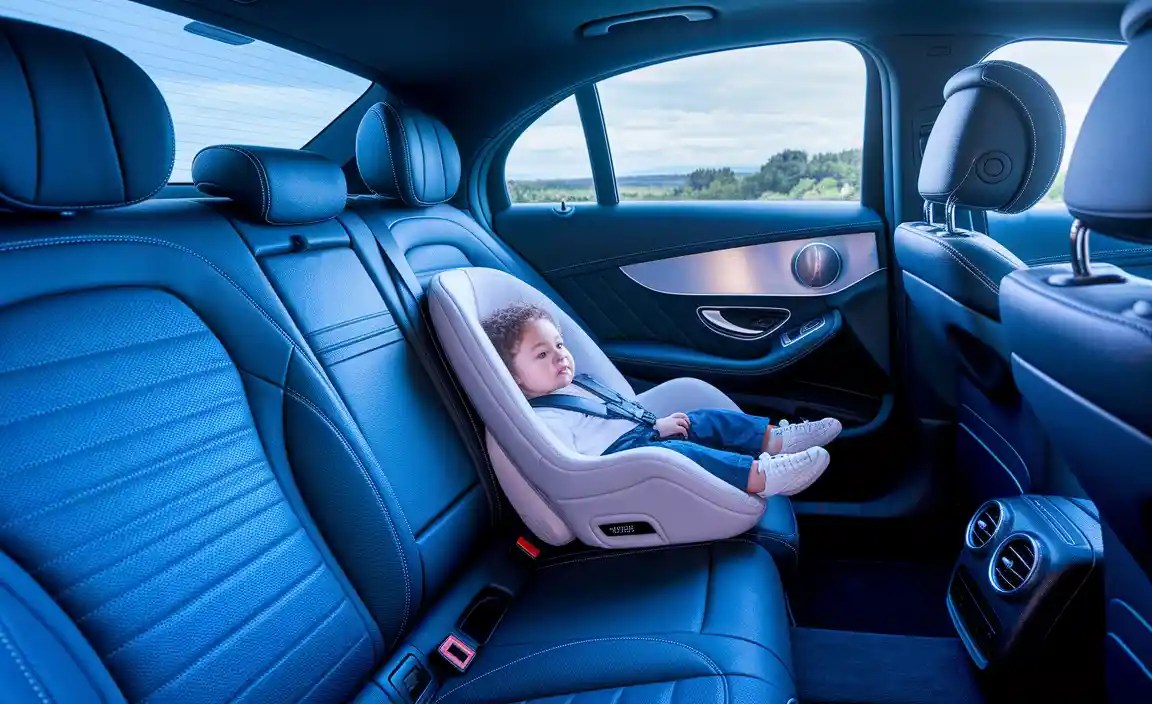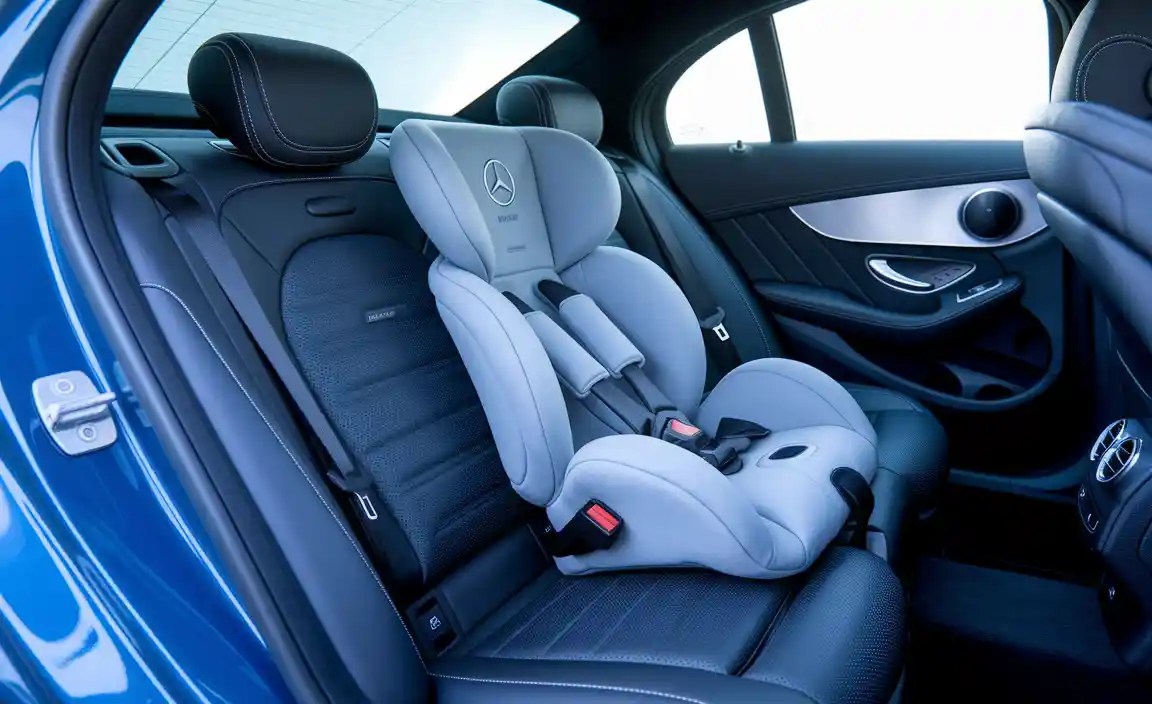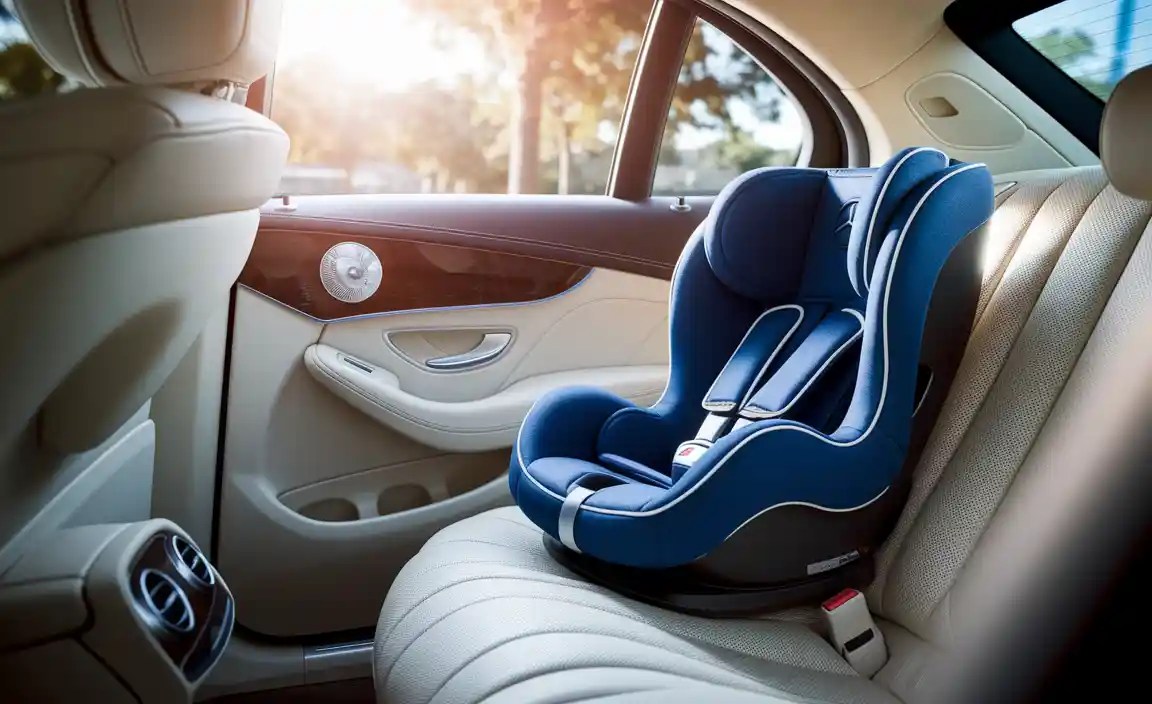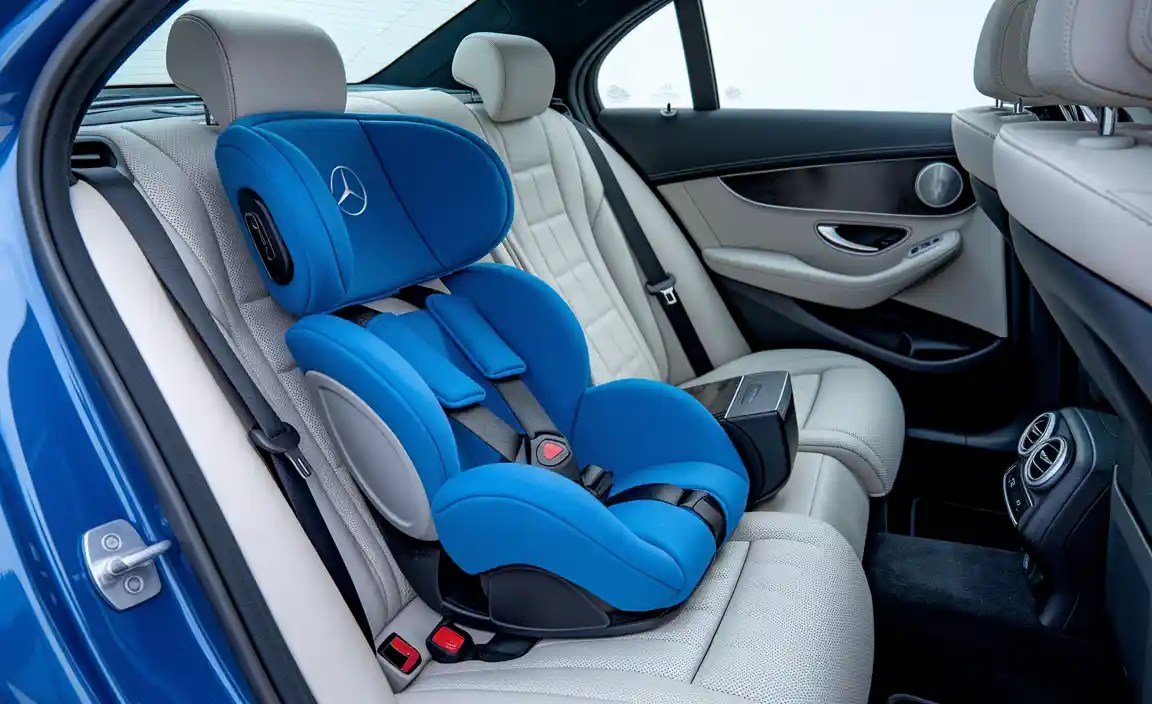Mercedes-Benz C Class Child Seat: Your Perfect, Effortless Safety
Your C-Class child seat should be chosen for safety, ease of installation, and a perfect fit within your Mercedes-Benz C-Class. Look for seats that meet current safety standards and are compatible with your specific C-Class model year, ensuring effortless installation and peace of mind for every drive.
Bringing a new addition into your family is an incredibly exciting time, and for Mercedes-Benz owners, ensuring that little one travels in unparalleled safety and comfort is paramount. The Mercedes-Benz C-Class, known for its sophisticated design and advanced safety features, deserves a child seat that complements its high standards.
However, navigating the world of child seats can feel overwhelming. With so many options, safety regulations, and car-specific considerations, finding the “perfect” seat might seem like a daunting task. This guide is designed to demystify the process, offering clear, actionable advice to help you choose and install the ideal child seat for your C-Class, making safety effortless and worry-free.

Understanding Child Seat Safety and Your Mercedes-Benz C-Class
Safety is the absolute priority when it comes to transporting children. Even in a vehicle renowned for its safety engineering, like the Mercedes-Benz C-Class, the correct child seat is indispensable. Regulations and best practices evolve, so understanding the current standards is key. In the United States, the National Highway Traffic Safety Administration (NHTSA) provides comprehensive guidelines and recommendations for child passenger safety.
These guidelines cover everything from selecting the right seat for your child’s age and weight to proper installation techniques. You can find valuable resources on their official website: NHTSA’s Car Seats and Child Restraints. Mercedes-Benz vehicles, including the C-Class, are equipped with LATCH (Lower Anchors and Tethers for Children) systems, a standardized way of attaching child seats.

However, the specific placement and ease of access to these anchors can vary slightly between model years and even specific C-Class trims. Understanding your C-Class’s unique features, such as seat contours and the presence of ISOFIX points (the European equivalent of LATCH), will contribute significantly to a secure and proper installation. Our goal is to ensure your child is as protected as possible, making every journey secure and comfortable.
Key Factors When Choosing a Child Seat for Your C-Class
Selecting the right child seat involves more than just picking one that looks good. Several critical factors must be considered to ensure the best fit for your child and your Mercedes-Benz C-Class. These elements directly impact the seat’s effectiveness in protecting your child in the event of a collision.
1. Child’s Age, Weight, and Height
Child seats are categorized based on the child’s developmental stage. It’s crucial to choose a seat that accommodates your child’s current size and will continue to fit them for the recommended duration. Adhering to these guidelines ensures the seat’s safety features are optimally utilized.
- Rear-Facing Car Seats: Suitable for infants and toddlers. Most models are designed for children starting from birth up to 2-3 years old, or until they reach the seat’s maximum height or weight limit for rear-facing. Keeping children rear-facing for as long as possible is statistically the safest option.
- Forward-Facing Car Seats: For toddlers and preschoolers who have outgrown their rear-facing seats. These typically accommodate children from roughly 1 year old up to 4-7 years old, depending on the seat’s limits.
- Booster Seats: Used for older children who have outgrown forward-facing seats but are not yet tall enough for the vehicle’s seat belt to fit properly. Boosters raise the child so the vehicle’s lap and shoulder belts fit correctly over their hips and shoulder.
2. Safety Standards and Certifications
Always look for seats that meet or exceed the latest safety standards. In the US, this means a seat certified by the NHTSA. In Europe, look for ECE R44/04 or ECE R129 (i-Size) standards. These certifications indicate that the seat has undergone rigorous testing for crash protection.
- NHTSA Certification: Ensures the seat meets U.S. federal safety standards.
- ECE R129 (i-Size): A newer European standard that emphasizes side-impact protection and uses height as the primary criterion for fitting.
3. Ease of Installation in Your C-Class
A seat that is difficult to install correctly is less safe. Look for seats with clear installation instructions and features that simplify the process. Knowing your C-Class’s LATCH system anchor points will also be beneficial. Some seats offer:
- Built-in lock-offs: These help to secure the seat belt or LATCH strap tightly.
- Level indicators: To ensure the correct angle for rear-facing seats.
- Clear belt paths: Marked routes for threading the seat belts or LATCH straps.
4. Fit Within Your C-Class Interior
The C-Class, while a premium vehicle, is a compact executive car. Space in the rear can be a consideration, especially if you have an infant car seat that needs to be installed rear-facing which can take up significant front passenger seat legroom. Booster seats are generally less bulky. Measure the space if you have concerns, and consider trying a seat in your car before purchasing if possible.
5. Comfort and Features
While safety is paramount, comfort is also important for longer journeys. Consider padding, adjustable headrests, and breathable fabrics. Features like cup holders or easy-to-clean covers can add to the overall convenience.
Types of Child Seats and Their Suitability for the C-Class
Understanding the different types of child seats will help you narrow down your choices based on your child’s needs and how they integrate with your Mercedes-Benz C-Class.

Infant Car Seats (Rear-Facing Only)
These are designed for newborns and young infants. They typically feature a detachable “carrier” that clicks into a base installed in the car, making it easy to transport a sleeping baby without disturbing them.
For a C-Class, these are generally a good fit, but always check the recline angle to ensure it’s appropriate for a newborn. Rear-facing infant seats can consume considerable space, so measure carefully if the front passenger seat will be occupied by an adult.
Convertible Car Seats
These seats can be used both rear-facing and forward-facing. They are versatile and can last your child through multiple stages, often from birth up to around age 6 or 7, depending on the weight and height limits. Convertible seats are a popular choice for their longevity. When installed rear-facing in a C-Class, they can also take up significant space. Ensure the recline works with your car’s seats.
All-in-One (Combination) Car Seats
Similar to convertibles, these seats can transition from rear-facing to forward-facing and then to a booster seat. They are designed to be the only car seat you’ll need. Their size can be substantial, so checking the fit in your C-Class is essential, particularly in rear-facing mode.
Booster Seats
Once your child has outgrown their forward-facing car seat, they will transition to a booster seat. These use your car’s seat belt to restrain the child. There are two main types:
- High-Back Boosters: Offer head and neck support and can improve the shoulder belt fit. These are excellent for cars that might not have headrests that sufficiently support the child’s head when sleeping.
- Backless Boosters: More portable and compact, but offer no head support. Ensure the vehicle’s seat and headrest provide adequate support.
Booster seats are generally easier to fit in a C-Class due to their smaller footprint. Using a booster ensures the vehicle’s seat belt fits correctly, typically when the child reaches about 4 feet 9 inches tall and between the ages of 8 and 12.
Installing a Child Seat in Your Mercedes-Benz C-Class: A Step-by-Step Guide
Proper installation is critical for child seat safety. Mercedes-Benz vehicles are equipped with LATCH systems to make this process more straightforward. Let’s walk through the general steps, assuming you’re using the LATCH system, which is commonly found in C-Class models from 2003 onwards (check your specific owner’s manual for confirmation and location of anchors).

Step 1: Consult Your Manuals
Before you begin, read both your Mercedes-Benz C-Class owner’s manual and the child seat manufacturer’s instruction manual thoroughly. Your C-Class manual will detail the location of the LATCH anchors and any specific recommendations or restrictions for car seat installation.
For your C-Class: LATCH anchors are typically located in the rear seats. Look for small labels or slits in the seat bight (where the seat back meets the seat cushion). There are usually three sets of lower anchors in larger vehicles, but typically two in the C-Class, one for each outboard seating position.
Step 2: Prepare the Child Seat
For rear-facing installation, ensure the seat is at the correct recline angle. Most infant seats have adjustment features or built-in indicators for this. For forward-facing, ensure the harness is set at the correct height for your child (usually at or above shoulder level).
Step 3: Locate and Access LATCH Anchors
In your C-Class, find the lower anchors. For the rear seats, they are usually found in the crease between the seat cushion and the seatback. You may need to push the seat cushion down slightly to fully access them. The top tether anchor, used for forward-facing seats, is typically on the back of the seat, the rear deck, or the ceiling, depending on the C-Class model year. Again, consult your manual.
Step 4: Attach the Child Seat to the Anchors
Connect the lower anchors on the child seat to the lower anchors in your C-Class. Most LATCH connectors are either U-shaped metal hooks or fabric straps with connectors. Ensure they click securely into place.
- For rear-facing: Attach the lower anchors and ensure the seat is firm.
- For forward-facing: Attach the lower anchors and then connect the top tether strap to the top tether anchor point in your C-Class and pull it snug.
Step 5: Tighten the LATCH Straps
Once connected, apply firm pressure to the child seat as you pull the LATCH straps to tighten. The goal is to reduce slack as much as possible. Use your non-dominant hand to push down on the child seat while using your dominant hand to pull the LATCH strap webbing.
Step 6: Perform the “Wiggle Test”
This is a crucial step. Grasp the child seat at the belt path (where the LATCH strap or seat belt passes through) and try to move it side-to-side and front-to-back. The seat should not move more than one inch in any direction. If it moves excessively, you need to tighten the straps further or reposition the seat.
Step 7: Check Recline Angle (Rear-Facing)
For rear-facing infant or convertible seats, verify that the recline angle is correct for your child’s age and weight. Most seats have indicators, like a bubble level or lines, to help you achieve the proper angle. An incorrect angle can be dangerous for an infant’s airway. Your C-Class owner’s manual might also have specific advice on recline angles.
Step 8: Secure Your Child
Once the seat is securely installed, place your child in the seat and secure the harness. For rear-facing, the harness straps should be at or below shoulder level. For forward-facing, they should be at or above shoulder level. The harness should be snug – you shouldn’t be able to pinch any slack between your fingers at the child’s collarbone. Ensure the chest clip (if applicable) is positioned at armpit level.
Using the Seat Belt for Installation (If LATCH is Not Available or Preferred)
While LATCH is convenient, using the vehicle’s seat belt is also a safe and effective installation method, often recommended by manufacturers for certain scenarios or once the child is heavier. This is particularly relevant for older C-Class models that might have a different LATCH implementation or when the LATCH weight limits are exceeded.
General Steps for Seat Belt Installation:
- Consult Manuals: Always begin by reading your C-Class and child seat manuals.
- Route the Seat Belt: Follow the belt path guides on the child seat, ensuring the seat belt is not twisted. For rear-facing, the seat belt will route differently than for forward-facing.
- Lock the Seat Belt: Most modern car seat belt systems can be locked to hold the child seat tightly. Check your C-Class manual for how to engage the seat belt’s locking mechanism, usually by pulling the belt out fully to the end of its range to activate a locking retractor, or by using a built-in lock-off device on the car seat itself.
- Press Down and Tighten: Apply significant weight to the child seat (like sitting on it) while tightening the seat belt.
- Perform the Wiggle Test: Ensure the seat is secure and does not move more than one inch.
- Top Tether (Forward-Facing): Attach and tighten the top tether to its anchor point for forward-facing installations.
Some child seats come with built-in lock-offs that simplify this process, making it easier to achieve a tight installation every time without needing to figure out the car’s specific seat belt locking mechanism.
Mercedes-Benz C-Class Specific Considerations for Child Seats
While the C-Class is designed with safety in mind, there are a few nuances that might affect child seat installation or fit compared to larger vehicles.

Rear Seat Contour and Slope
The rear seats in a C-Class are sculpted for comfort and style. This contour can sometimes make it challenging to get a perfectly level rear-facing infant seat. Some seats have built-in leveling feet or multiple recline positions that can help compensate for this. Always ensure the seat is at the manufacturer’s recommended angle.
ISOFIX vs. LATCH
If you own a European-spec C-Class or have imported one, you’ll likely encounter ISOFIX instead of LATCH. While functionally very similar (both use lower anchor bars), the specific anchor spacing and top tether configurations might differ. The principle of secure attachment remains the same. For North American C-Class models, the system is known as LATCH.
Seat Belt Length
While less common with newer C-Class models, very old vehicles or aftermarket seat modifications could potentially have shorter seat belts that make it difficult to achieve a tight installation, especially with certain car seats. If you encounter this, it might be worth consulting a certified Child Passenger Safety Technician (CPST).
Occupant Safety Features
Your C-Class is equipped with advanced airbags and crumple zones. When a child seat is installed, ensure it doesn’t interfere with the deployment path of any side airbags (though most rear-seat airbags are designed to be safe with child seats, always check your manual). For the front passenger seat, child seats should generally NOT be placed there if the vehicle has an active front passenger airbag. Rear seat placement is always the safest option.
Top Child Seat Recommendations for the C-Class (General Guidance)
Choosing a specific brand and model can depend heavily on personal preference and immediate availability. However, brands consistently rated highly for safety, ease of use, and good fit in various vehicles, including sedans like the C-Class, include:
| Seat Type | Recommended Brands/Models (Examples) | Key Features for C-Class Fit |
|---|---|---|
| Infant Car Seats (Rear-Facing Only) | Chicco KeyFit 30 / KeyFit 35 Britax B-Safe Gen2 |
Easy installation base, good recline indicators, narrow profile to maximize front seat adjustment. |
| Cybex Cloud Q / Nuna Pipa series | Often feature advanced ergonomics and premium materials, check specific dimensions. | |
| Convertible Car Seats | Graco Extend2Fit / Britax Boulevard series | Adjustable recline for better fit, extended rear-facing use, durable construction. |
| Clek Foonf / Fllo | Known for slim design, allowing for potentially 3 across installation in larger vehicles (though less likely in a C-Class). Excellent safety ratings. | |
| Booster Seats (High-Back & Backless) | Graco Nautilus series (All-in-One convertible to booster) Britax Pinnacle / Grow Factor series |
Adjustable headrests, comfortable padding, ease of belt positioning. |
| Chicco KidFit / Graco TurboBooster | Lightweight, easy to clean, good belt guides. |






